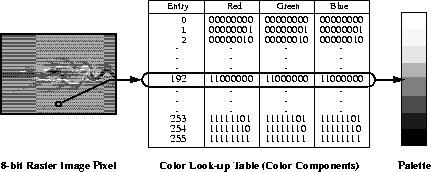[Top] [Prev] [Next]
9.2 The Palette Data Model
A palette is the means by which color is applied to an image and is also referred to as a color lookup table. It is a table in which every row contains the numerical representation of a particular color. Palettes can be many different sizes, but HDF only supports palettes with 256 colors, corresponding to the 256 different possible pixel values (0 to 255) in 8-bit raster images.
For each of the 256 colors in a palette, there are three 8-bit numbers describing its appearance. (See Figure 9a.) Each 8-bit color component represents the amount of red (or "R"), green (or "G"), or blue (or "B") used to create a particular color. In HDF, 8-bit palettes are assumed to be organized as follows; each entry consists of three bytes: one each for R, G, and B value. The first group of three bytes represent the R, G, and B values of the first color in the palette; the next three the R, G, and B values of the second color; and so forth. Therefore, the 256 possible different pixel values in an image serve as an index for the 256 color entries stored in the palette.
FIGURE 9a - Color Mapping Using a Palette

In the HDF library, there are four interfaces that support the reading and writing of palette data; the raster image interfaces, covered in Chapter 6, 8-Bit Raster Images (DFR8 API), Chapter 7, 24-bit Raster Images (DF24 API), Chapter 9, Palettes (DFP API), and the DFP palette interface covered in this chapter. The raster image interfaces store palettes with raster images and the palette interface reads and writes palettes outside of raster image sets. Palettes stored using the palette interface are stored as isolated data objects. In other words they are not included as members of any set, although they can be grouped with other objects using the Vgroup interface. For more information on the Vgroup interface, refer to Chapter 5, Vgroups (V API).
[Top] [Prev] [Next]
hdfhelp@ncsa.uiuc.edu
HDF User's Guide - 05/19/99, NCSA HDF
Development Group.

